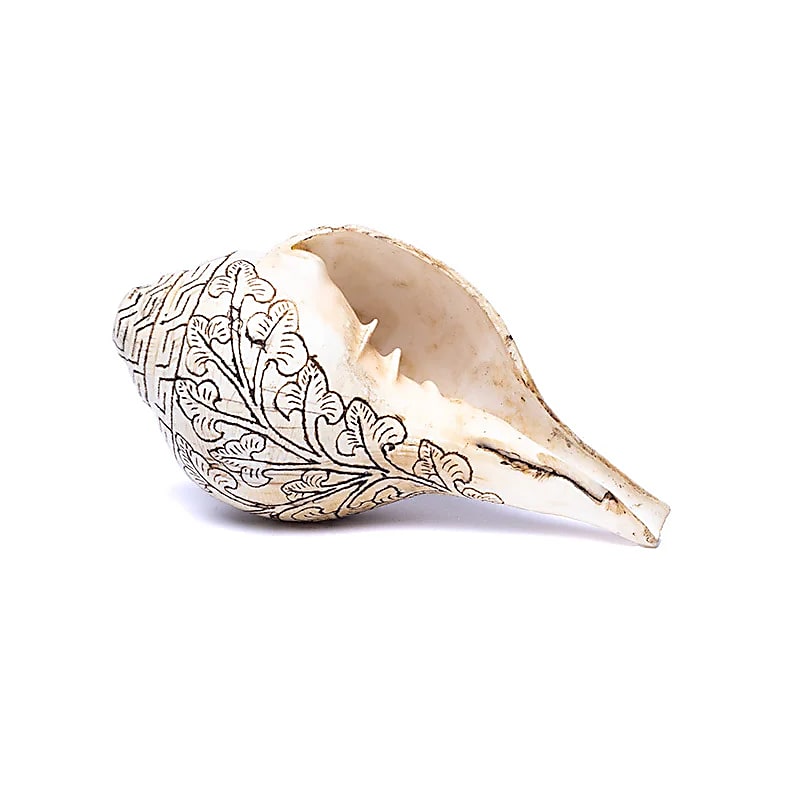Conch/Dun from Nepal, 18 x 8 centimeters x 8 high. With engraving of the prayer OMPH*, superb and authentic piece!
Conch/Dun from Nepal, 18 x 8 centimeters x 8 high. With engraving of the prayer OMPH*, superb and authentic piece!
Couldn't load pickup availability
- ✧─────✧
About the product:
🛕 Name/ Type: Conch/ Dun/ Shankha - A sacred instrument whose origins date back to ancient India, long before the Buddhist era
🌍 Origin: Nepal
🕰️ Year: Estimated 2020
📐 ⚖️ Dimensions: +/- 18 x 8 x 8 centimeters
⚖️ Weight: +/- 685 grams
🧬 Material: Shell (Turbinella pyrum)
✨ Care: Gentle cleaning, avoid excessive humidity, gentle polishing if necessary
📦 Packaging: Individually - Wrapped in paper
🎁 Ideal for giving as a gift or treating yourself!
🛕 History and symbolism
The conch shell, or dungkar in Tibetan, is a sacred ritual instrument whose origins date back to ancient India, long before the Buddhist era.
In the Vedas (Hindu sacred texts, circa 1500 BC), the conch shell—called a śaṅkha —was used as a ceremonial trumpet to call upon the gods, announce battles, or celebrate spiritual victories.
With the spread of Tantric Buddhism (Vajrayāna) from the 7th century onwards, this instrument was integrated and transformed into a symbol of peace and awakening.
Instead of announcing war, the Buddhist conch now proclaims the voice of the Dharma, that is, the teaching of the Buddha which resonates in the ten directions of the world to awaken all beings.
📯 Function and ritual use
In Tibetan monasteries, the conch is used as an instrument of sacred music:
- It is used to announce ceremonies and bring monks together for prayer or meditation.
- It accompanies sound offerings and tantric rituals, notably those dedicated to Avalokiteshvara (Chenrezig) or Guru Rinpoche (Padmasambhava).
- Its deep, low sound is believed to purify space, dispel negative energies and awaken spiritual awareness.
In some monasteries, we distinguish:
- The large conch shell, blown from rooftops during public rituals.
- The small, richly decorated ritual conch shell used on the altar as a symbolic offering object.
💎 Spiritual symbolism
The conch is one of the Eight Auspicious Symbols of Buddhism ( Ashtamangala ), alongside the endless knot, the lotus, the wheel of Dharma, the victory banner, the vase, the fish and the umbrella.
It symbolizes:
| Appearance | Meaning |
|---|---|
| The Sound of Dharma | The voice of the Buddha resonating throughout the world, awakening beings to the truth. |
| The spread of wisdom | The teaching that spreads without obstacle, like sound that propagates in space. |
| Purity | The pristine echo of compassion and truth. |
| Spiritual vigilance | The constant reminder to listen, hear and practice the Dharma. |
The clear, deep sound of the conch is considered a purifying vibration: it dissolves ignorance and opens the heart to right understanding.
🔁 Symbolism of the conch turning right
A very important detail distinguishes the Buddhist conch:
It is often coiled to the right ( dakshina-varta shankha ), unlike the majority of natural conchs, which coil to the left.
This rare form is highly sacred, as it symbolizes:
- The movement of the sun and planets in the positive cosmic direction.
- The whirlwind of Dharma unfolding in the world.
- The movement of the human heart towards compassion.
Thus, the conch turning to the right represents the awakened speech of the Buddha, always beneficial and harmonious.
⚒️ Manufacturing and decoration
Tibetan ritual conch shells are often:
- Polished and hollowed to produce a harmonious sound.
- Adorned with finely chiseled silver, gilded copper or brass mounts.
- Decorated with precious stones (turquoise, coral, lapis lazuli), symbolizing light, compassion and wisdom.
- Engraved with mantras like Om Mani Padme Hum , amplifying their spiritual power.
Some conches, too precious to be blown, are placed on the altar as permanent sound offerings.
🌺 The conch in iconographic representations
In Buddhist iconography:
- Shakyamuni Buddha and the bodhisattvas of speech (notably Manjushri) are sometimes depicted holding a conch shell.
- Protective deities use the conch as an instrument to proclaim the victory of Dharma over ignorance.
- In tantric mandalas, it appears in the corners, representing the harmonious diffusion of wisdom in the four directions.
🕊️ Conclusion
The Buddhist conch (Dungkar) is much more than an instrument:
She is the voice of the Buddha, the breath of the Dharma, and the living symbol of inner awakening.
Its pure and vibrant sound reminds everyone that truth is not imposed, but spreads naturally, like a wave of compassion that crosses the world.
“The sound of the conch shell awakens not warriors, but consciences.”
- ✧─────✧
A question? A comment? | Order and delivery information
A question? A comment? | Order and delivery information
⋯⋯⋯⋯⋯⋯⋯⋯⋯⋯⋯⋯⋯⋯⋯⋯⋯⋯⋯⋯
📞 Customer service available from Tuesday to Saturday , from 10am to 7pm (French time)
- 🇫🇷 From France: 06 51 85 38 18
- 🌍 From abroad: +33 6 51 85 38 18
- 💬 Live chat: via the bubble in the bottom right corner of your screen
- 📧 Email : available 24/7 – we respond quickly!
⋯⋯⋯⋯⋯⋯⋯⋯⋯⋯⋯⋯⋯⋯⋯⋯⋯⋯⋯⋯
🔖 Order today and receive your package within 2 to 10 days depending on your continent.
💳 Secure payment & certified by SSL encryption 🔐
↩️ Returns & exchanges possible within 14 to 30 days after receipt.
🌍 Shipping costs are calculated automatically based on your shipping address at checkout.
📦 Country of shipment: France 🇫🇷
Share







